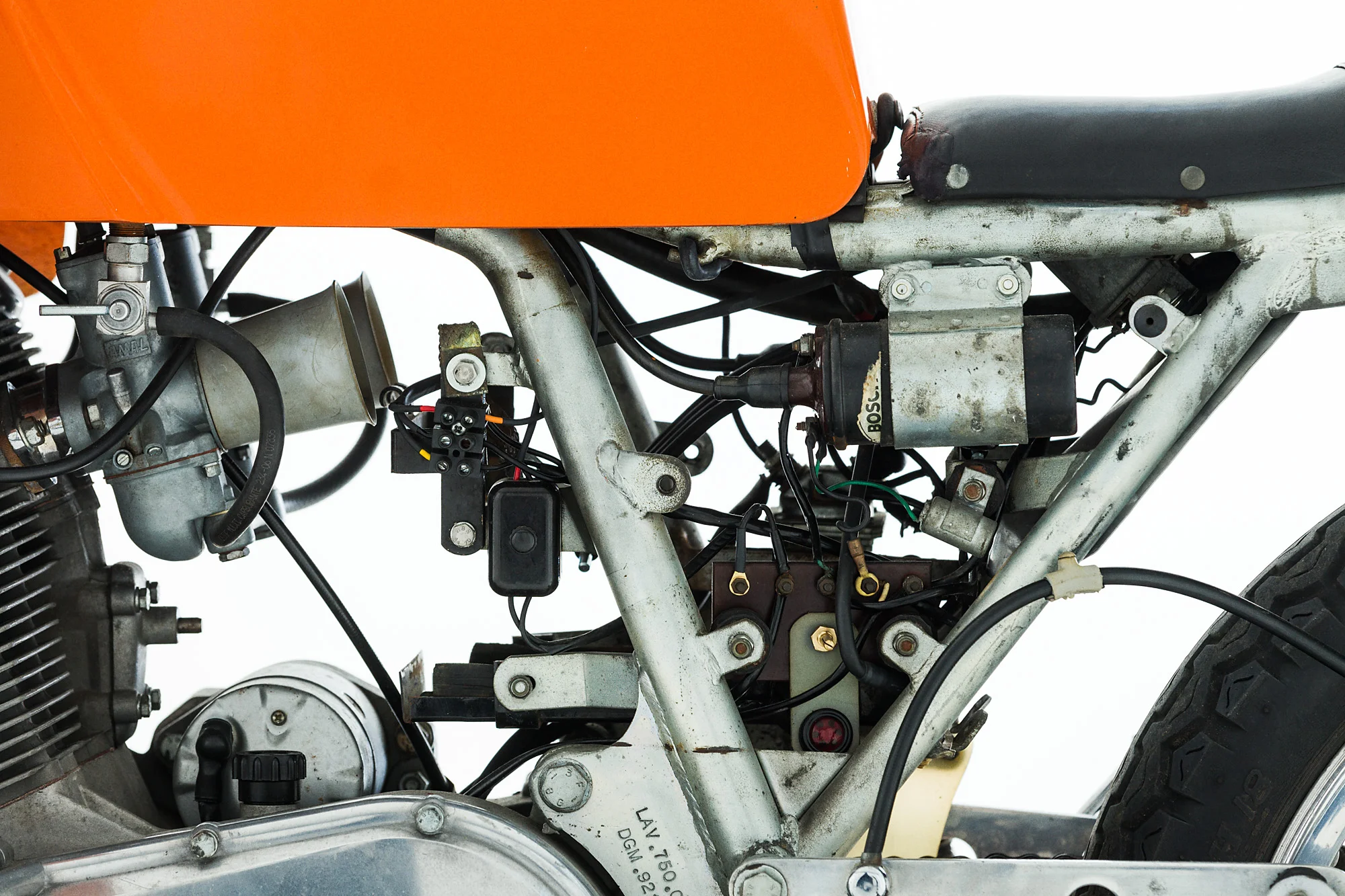
UNRESTORED 1971 Laverda 750 SFC
SOLD — (08,2021)
SOLD — (02,2017)
From Laverda's second production series, the 8000 batch. This is one of only 78 machines produced from that run. One of two (known) machines that is still in its original form FROM THIS BATCH. A true survivor indeed.
THIS SPECTACULAR SFC HAS BEEN PREVIOUSLY SOLD BY MOTO BORGOTARO TWO TIMES IN THE LAST 6 YEARS AND IS NOW AVAILABLE AGAIN FOR ACQUISITION. IN ORDER TO UNDERSTAND THE RARITY OF SERIES ONE AND TWO SFC’S, ONE MUST REMEMBER NONE WERE IMPORTED INTO THE US AND INDIVIDUALS WERE ONLY ABLE TO PURCHASE DIRECTLY FROM THE FACTORY IF THEY WERE PRIVATEER RACERS. THE TRUE SPORTING HERITAGE OF LAVERDA’S EARLY SUCCESS IN RACING HISTORY SPAWNED THIS ICON OF THE 1970S. THIS IS ONE OF NONE.
Frame and engine # 8329
The 1971 Giuffrida Laverda 750 SFC # 8329 was delivered from Moto Laverda’s old Breganze (Vicenza) factory on Thursday, January 13, 1972 for delivery to Amedeo Motor in Messina, a ferry port closest to the toe of Italy, in Sicily. New Amedeo Motors e Co SrL still exists there today as a motorcycle dealer.
Registration was completed nearly three weeks later done on February 4th. Amedeo Motor’s 1st buyer was one Giovanni Battista Giuffrida of Via G. D’Annunzio 31, 95100, Catania. The same Catania – big university city and fishing port some 60 miles due south of Messina – that was buried by Mt. Etna on a couple of occasions.
1971 Laverda 750 SFC DETAILS
Sold new into Sicily, then via the Netherlands into the US in 2016. 2016-2023 passed on to (2) private owners, lovingly cared for and in perfect running condition still
An original “survivor”, unrestored with superb patina
One of only 78 second generation (8000-batch) 750 SFCs; all of which carried homologation no. DGM 9217 OM
Recently brought into the open having been hidden until 2016
All the original papers are available - the Libretto, the ACI ‘Foglio Complimentare’ as well as the Warranty Certificate
"Giuffrida used the SFC solely as a road bike and it is clear that he hardly used it at all, even though it remained in his possession until 2007. From Catania it found its way to the Netherlands and then recently to America’s East Coast."
Giuffrida’s 750 SFC is perhaps one of two very few remaining machines from Laverda’s 8000 batch that has survived intact. Moto Laverda made two production runs for the 8000 batch, five machines then 73, for a total of 78, in late 1971. #8329 was one of the last, the very last being # 8356. (Laverda mixed the SFC batches into their roadster numbering sequence.) Laverda factory rider and team leader of the day, Roberto Gallina once told Tim Parker that between the SFC and Ducati’s “green frame” bevel 750 SS, “there was nothing in it performance wise”. In 1972, many SFCs were raced successfully both nationally and internationally, but in many cases they continued to be raced by lesser gods often not getting the proper care they needed. Wear and tear took a heavy toll on the 8000 batch.
Seventy-eight
(#8000-batch) machines were made. This bike #8329 was one of the last.
Many components were different from the later #5000-batch although the engine and transmission were to a similar specification.
The front rim is a Borrani WM3 item that is correctly stamped 4446. Like all Laverdas, each wheel has 36 spokes. The retaining arm is a chromed steel item made by Laverda.
All 750 SFCs were orange. But notice the different shades on this example. One of the first aspects that catch the eye are the differences in the orange color of the bike. This can be explained only by the fact that the 8000 batch SFC had all orange parts painted, except the tank, which was finished with an orange gel-coat. This gel-coat has uniquely faded like the painted parts have but in differing degrees and shades.
Yet another reason for its rarity is the “self-destruction” of the very thin fiberglass parts from the (5000 and) 8000-batch SFC. They tended to crack, some said simply by looking at them. Replacement original NOS fairings, front mudguards, tanks and seats are virtually impossible to find today. Original SFC tanks are very rare too.
Laverda’s frame and engine numbers in this period always matched, thus the bikes are always known by a four-digit number. The frame number has the “‘LAV 750 C”’ prefix, as was common on all drum brake SFCs. On the lower left rear of the crankcase one can see the “SFC” stamping which is correct for the 8000 batch. The engine number is stamped on the left side of the crankcase.
Ceriani supplied the front forks—painted orange over black—and the rear suspension units mounted further back on the frame sides than the later batch.
Most of the “consumables” on # 8329 are those still original and as it left the factory with. The: Dunlop TT100 tires, made in England, in size (4.10 x 18 front and rear) are period, even though the rear tire has been removed and re-fitted at some point as the marks on the rear rim show. The sprockets and secondary drive chain are still the original items. All the cables and most of the wiring harness are original, all proof of very little use.
THE ENGINE
The engine is untouched, it has never been opened, meaning that its internal condition is strictly speaking unknown. Such is the inherent strength of the build specification, the quietness and smoothness of this engine when operating, that there is little to fear as to its condition. Thus I can’t comment on the internals. The crankcase is correctly stamped (at the factory) # 750*8329*. All the fasteners on the engine are the originals. The traces of the white gasket cement that the factory used can still be seen on the mating faces of the crankcase. Inside the engine one can expect the 9.6:1 Mondial 9.6 : 1 pistons, Laverda’sthe 2/C camshaft, a highly polished SFC crankshaft and connecting rods, and the close-ratio gearbox that made its debut in the 8000 batch. The correct ‘Shell-branded ’ (crankcase) oil dipstick is there, with white paint on the tip to ease reading the oil level.






